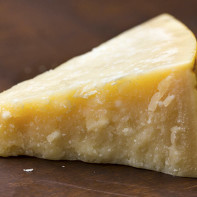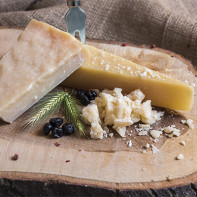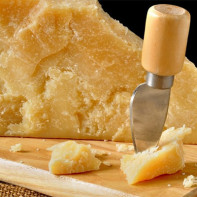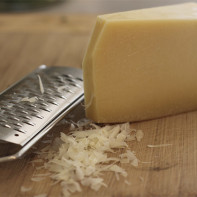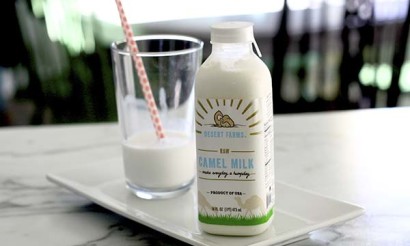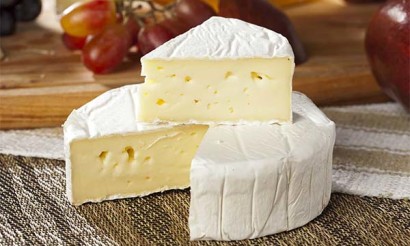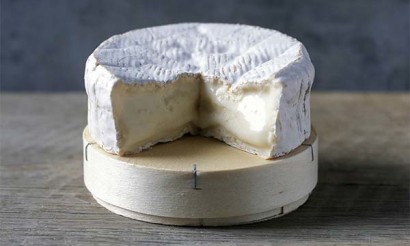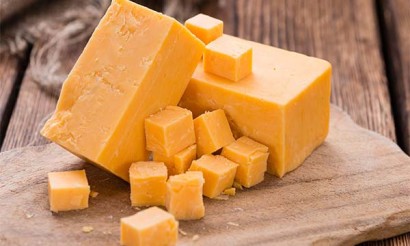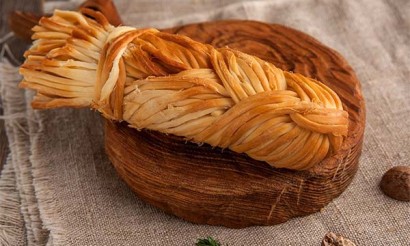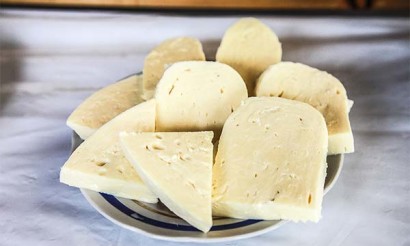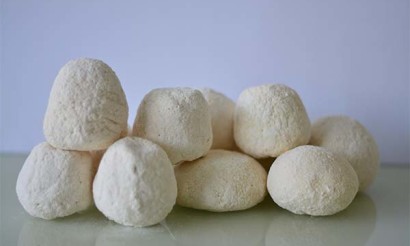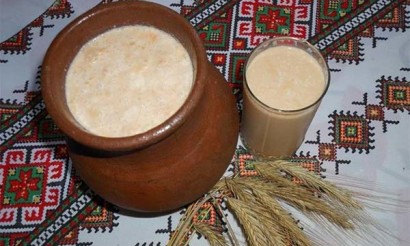Parmesan: what is this cheese, useful properties, recipes
Parmesan is a kind of hard cheese, which is obtained from the milk of cows and has a brittle structure. The product is harvested during the period from April to November. In this case, the milk collected on the previous day, from which the cream has already been removed, is mixed with the raw material collected the next morning, and subjected to heat treatment in special containers. This is done so that the multiplication of lactobacilli takes place. Then rennet is added, which is necessary to curdle the liquid into lumps of the future cheese product. The formed curd lumps are collected from the vat, put into molds and left to drain all the whey. A day later the future cheese is salted for a week in brine. After that the product is sent to ripening. This takes up to two years.
- Types of Parmesan
- What's the difference between regular Parmesan cheese
- Composition and calories
- What is the usefulness of parmesan cheese
- General benefits
- For Women
- For Men
- For Pregnancy
- For breastfeeding
- For children
- Losing weight
- Culinary Applications of Parmesan
- What to eat with
- What can be substituted for the parmesan?
- Hazards and contraindications
- How to choose and store the Parmesan cheese
- Can I freeze it?
- How to soften dried Parmesan cheese
- Why does the Parmesan cheese get moldy?
- How to Make Parmesan Cheese at Home
- What can be made with Parmesan: Recipes
- Baked pepper appetizer
- Country Parmesan Cake with Chicken
- Interesting facts about parmesan
To prevent the formation of voids and the development of mold, each round, which can weigh up to 40 kg, should be periodically tapped, turned and, if necessary, wiped. The best period of aging of cheese is considered a time period of one to three years. During this period, the product matures in a room where special temperature requirements are observed. The result is a cheese with a pleasant nutty aroma and a special flavor.
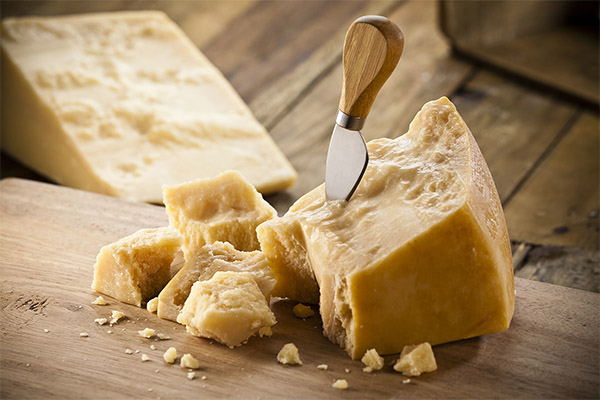
To cut the delicacy use special knives with the wedge principle, which break it into small pieces. If the product breaks, crumbles and is cut unevenly, then the cheese is ready. Cheese circles are branded with a quality mark, and then they are sent for sale.
European laws prohibit calling a cheese Parmesan if it was made in other countries using Italian technology.
Types of Parmesan
Parmesan comes in three varieties:
- Young, which matures within 1 to 1.5 years. The product is served as an appetizer and dessert. Goes well with fruit.
- Old cheese, which matures for one and a half to two years. In cooking used for cooking second courses and hot appetizers.
- Very old cheese, which matures for two or three years. It is recommended to use grated. It is used in the manufacture of pizza, as well as to give the finished dish a specific flavor.
Maturation period of Parmesan does not always take three or four years. Some varieties of product can last up to ten years in storage before going on sale in stores. It is worth noting that the longer a dairy product matures in storage, the harder it becomes. The grains of such a product are more pronounced.
How Parmesan cheese differs from ordinary parmesan cheese
High quality Parmesan cheese has a spicy-salty flavor with a touch of hazelnuts and fruit. This product differs from other types of cheese not only in taste, but also in structure. Due to the dense consistency of the cheese can be ground on a grater very thin, airy shavings. When exposed to high temperatures it is able to melt evenly, covered with a golden crust, which solidifies during baking. Due to these properties, the cheese product can be used to make various salads and second courses.
The caloric value of parmesan is much lower than that of other varieties of cheese.
Composition and calories
Parmesan acquires many useful components in the process of ripening. It has a protein that is involved in the formation of skin cells, muscles, as well as in the production of various enzymes and hormones in the human body. This cheese contains more than 30% protein. This product is digested very quickly, in less than an hour.
Parmesan also contains calcium in combination with vitamin D. These components play an important role in bone health.
Vitamin A in the Italian product has important properties for eyesight, has a positive effect on the health of the skin and teeth. In addition, this substance takes part in metabolism.
Also this cheese delicacy is rich in saturated and unsaturated fatty acids, amino acids and essential amino acids.
Of mineral elements in Parmesan there is also iron, phosphorus, zinc and potassium. All these components, vitamins and other useful substances are quickly absorbed due to the fact that the product creates a fatty environment.
The caloric value of parmesan cheese (per 100 g) is 383 kcal.
How to use Parmesan cheese
General benefits
Italian cheese should be included in the diet of every person, because it has many useful properties. First of all, it should be noted that the product is a fast source of protein and calcium, because it is digested in 40-45 minutes. Parmesan has the ability to renew the cells of the body thanks to the amino acids, as well as protect cell membranes.
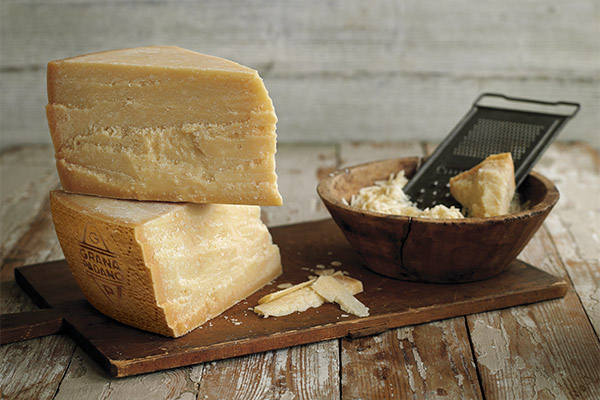
The product does not contain lactose, which allows including it in the menu of people prone to develop allergic reactions.
Cheese delicacy normalizes digestion, stimulates the formation of gastric juice and intestinal peristalsis. It can be used to prevent the development of chronic constipation. It takes part in the reproduction of beneficial bacteria that provide the intestines with normal microflora, which prevents the development of dysbacteriosis. Also, the use of the product is the prevention of osteoporosis, the development of tooth decay.
For women
Parmesan helps to relax the nervous system, reduce the manifestations of stress and depression. Cheese is highly nutritious. For example, a small piece of this product is able to relieve the feeling of hunger for a few hours. As the product improves metabolic processes, indirectly it affects the weight loss of the body.
The positive effects of parmesan on the condition of hair, skin and the health of the nail plate are also known.
For men
Cheese helps to strengthen the muscular corset, which is especially important during physical exertion.
Parmesan in a man's diet is the key to sound sleep. Experts even note that the product has an anticonvulsant effect, takes part in the production of hormones and enzymes.
When pregnant
During the period of carrying the baby, the diet of a pregnant woman should consist only of healthy products. Most varieties of cheese are contraindicated during this period. This applies to soft varieties of the product, as well as to varieties that contain a deep mold.
Parmesan, on the other hand, is a hard cheese with unique properties. It can be consumed during pregnancy. It can be of great benefit both to the mother and her baby, even if the product is obtained from milk, which has not been pasteurized. This is explained by the fact that this type of cheese is characterized by low moisture and low pH. This is achieved during a long ripening period. Such conditions contribute to the extinction of harmful bacteria.
No preservatives or chemical additives are used in the production of Parmesan. This product is considered one of the safest varieties of delicacy, which has a long shelf life. Even if stored at room temperature for two weeks, the product remains suitable for consumption. However, before consuming this delicacy, it is recommended to consult a doctor.
When breastfeeding
Parmesan cheese has many beneficial characteristics. Vitamin and mineral composition contributes to the normalization of the digestive process, strengthening the immune system, improving lactation.
In some cases, the product should not be used during breastfeeding. Should limit the use of cheese with abnormalities of the urinary system, because cheese contains sodium salts, which can be deposited in the kidneys.
Cheese of fatty varieties makes the breast milk more fatty. As a result, the baby has enough front milk for satiety, although it is not as healthy as the back milk. These products can also cause colic and loose stools.
You can introduce cheese into the diet of a breastfeeding woman from the first month after the birth of the baby. The product should be consumed in small portions, constantly monitoring the condition of the child.
For children
Parmesan hard cheese is known for the presence of a number of positive components. First of all, it is worth noting that the product is a source of animal protein (especially for children who do not like meat and milk). In addition, calcium and phosphorus are found in cheese. They take part in the development of the child's bone system. Vitamins in the composition of the Italian delicacy strengthen the child's body.
However, this cheese has some disadvantages. Parmesan is still a fatty product, which can put a load on the digestive system, which is not yet fully formed. Excessive consumption of Parmesan is dangerous for children due to its high salt content. You should also remember that cheese, like most dairy products, can cause an allergic reaction, so you should be careful to introduce the product in the diet of children prone to allergies.
As for the timing of the introduction of such hard cheese in the diet of a child, some believe that the product is difficult to digest by the child's body. Therefore, it is recommended to introduce Parmesan to children's food no earlier than three years of age. Some believe that the first test should be carried out after 12 months of age. Regarding the time of introduction and the daily rates at each age is recommended to consult with the pediatrician who supervises the child.
You can give your child hard cheese no more than 2-3 times a week. It can be grated and added to porridge, omelettes or mashed vegetables. To reduce the salt content of Parmesan, it can be soaked in water for several hours.
For weight loss
There is some debate as to whether Parmesan can be used while dieting. On the one hand, it is a delicacy of dairy origin, which is easy to digest and also saturates the body with useful substances. On the other hand, the cheese has a fairly high degree of fat content, which can not lead to weight loss. Still, the product is in the list of dietary products, therefore, you can include it in a diet menu. However, you need to follow some rules:
- It is better to consume Parmesan in the first half of the day and not more than two slices.
- It is important when losing weight not only to follow the diet, but also to increase physical activity.
- During weight loss, the goal should be not only to lose weight, but also to stay healthy. Therefore, to maintain muscle mass, you can use this cheese for salads, sandwiches, combine the product with solid pasta.
Adding Parmesan in the right proportion will not only allow you to get rid of extra pounds, but also to diversify your diet with healthy dishes that are enriched with vitamins and mineral elements.
After a workout, cheese will help muscles recover.
Using Parmesan in cooking
In Italy, Parmesan is considered an indispensable part of the table, as bread in our regions. It is grinded in order to sprinkle salads, added to pizza, pasta and various soups. This component is used to bake vegetable and meat delicacies in the oven. As a result, the dish acquires a golden and crispy crust.
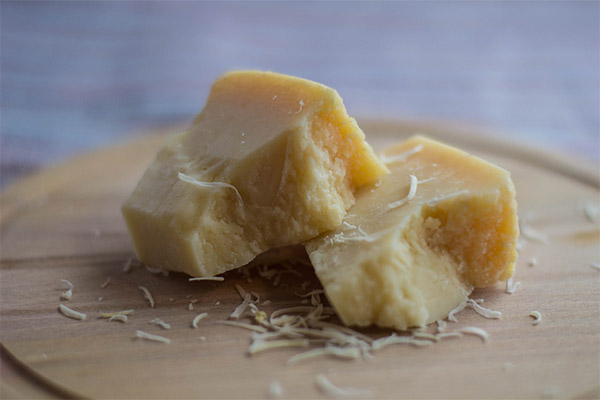
It is impossible to slice such a delicacy with an ordinary knife. Cheese has a firm, but at the same time brittle structure, and it is usually cut into small pieces that have an irregular shape. A special sharp knife with a rounded handle is used for this purpose.
What to eat with
In its homeland, this type of cheese is number one. Its use depends on the period of ripening. Parmesan that has matured for a year is usually used as an appetizer for a young wine with fruit and nuts.
Two-year-old Parmesan is added to salads, combined with pasta, fruit and vegetables. Thus, pasta flotschi with Parmesan is the most popular Italian dish.
Cheese aged for two or three years is excellent with red wine. If you cut such a product into plates, seasoned with balsamic vinegar, you get a good version of an appetizer for a house party or banquet.
Parmesan can diversify any recipe. Grated cheese is used to bake tomatoes, zucchini, from it prepare risotto. It is recommended to keep a little hard cheese at room temperature before slicing. This will reveal the aroma and pleasant flavors of the product.
Of course, Parmesan is an ingredient in pasta. The Italians even have a saying, which says that such a dish without the use of this cheese is like a woman without a nose.
What can be substituted?
Cheese is an ingredient in various culinary recipes. However, classic recipes for some dishes involve the use of hard cheese, which is not easy to find in the store. It is also quite expensive, so some people simply can't afford it. Parmesan cheese is characterized by its brittle and grainy texture, so it does not form threads on dishes when exposed to high temperatures. To make a head of this cheese requires half a ton of milk and about three years to mature. Naturally, the price of the finished product will not be small. Therefore, most hostesses wonder what to replace it with.
For this purpose, any other cheese belonging to the hard varieties will do. If, however, the taste of this cheese is important in the recipe, the only substitute option may be the Italian product "Grana Padano".
The damage and contraindications
Italian cheese, unfortunately, has some limitations and contraindications for use. Monosodium glutamate in the product is a preservative, so for the weakened or immature children's body this substance is dangerous to allergies or poisoning.
Sodium in large quantities itself is dangerous to human health. It is recommended to consume not more than 2.3 g per day, so you should not use Parmesan as a staple food. People over 50 years old, as well as those with diabetes and hypertension should also include this product in their menu with caution. Sodium is dangerous because it can retain water in the body, preventing the normal functioning of the excretory system, so the cheese is contraindicated in diseases of the kidneys.
Also, you should not eat Italian hard cheese with exacerbations of gastritis, pancreatitis, peptic ulcer.
How to choose and store parmesan cheese
The choice of parmesan requires special attention.
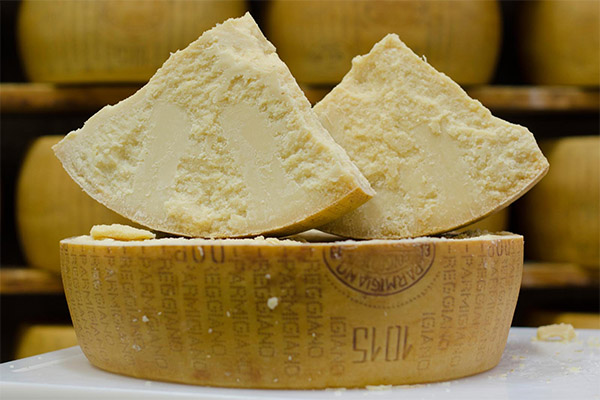
- Buy a piece of cheese that is cut from the head in the presence of the buyer. Only in such a product will be preserved the excellent taste of parmesan. We must remember that this cheese has the ability to absorb foreign odors, so it should not lie in the refrigerator next to the sausages and other products that can spoil the flavor.
- Real Italian Parmesan should have the quality mark imprinted on the head "D.O.P.", packaged pieces should be marked "P.D.O.".
- The denser the Parmesan, the longer it has been ripening. It is important to study the appearance of the product. A quality product has the color of melted milk and a golden crust of no more than 5-6 mm.
- The cheese has a grainy consistency. It cannot be cut, the pieces of such a delicacy break off. Amino acids in the composition of mature parmesan provide the product with a sandy structure. "Holes" in such cheese should be no more than 2 mm in diameter.
- You should also consider the smell of the cheese product. Fresh cheese has the smell of milk and grass. Old cheese has a more pronounced smell and a dense consistency. Cheese that is more than two years old is characterized by a variety of flavors.
Parmesan can be stored in the refrigerator for several months. From the time of manufacture, a head of cheese can be stored in the refrigerator for up to six months, preserving all the taste and nutritional properties. However, this is true if stored at a temperature no higher than 8 degrees.
If the cheese is bought in grated form, it can be stored in the refrigerator only for a week.
Before you put a piece of such cheese in the refrigerator, it should be wrapped in parchment and in foil.
Can freeze
Parmesan perfectly tolerates the process of freezing. Under the influence of low temperatures, the cheese will not lose its useful properties, moreover, it will retain its shape and will not crumble. In the freezer, this product can be stored for two months.
When storing Parmesan in the freezer, follow a few rules. Pieces of cheese should weigh from 250 to 500 grams, it is better to cut it in such pieces that when you defrost it was enough for a week's consumption, as the shelf life of defrosted cheese should not exceed seven days.
Before you take the Italian delicacy out of the freezer, it is recommended to keep it for a while on the bottom shelf of the refrigerator.
The shelf life of cheese in the freezer depends on how it is processed. If there is a hard slice of Parmesan, it can be kept in the freezer for up to six months, when storing slices shelf life is reduced to three months.
Defrosting should be done gradually, first in the refrigerator and then some time at room temperature.
You should not defrost the product in the microwave. So the cheese will just melt, and all its useful components will be lost.
How to soften dried Parmesan
Dried piece of cheese will be very difficult to grate. If in its fresh form it has a hard structure, dried it will be almost stone. Such a product can be used only for making pizza, risotto, vegetable salads.
To soften the Parmesan, you can soak it in cool milk for several hours. Some hostesses use the microwave for this purpose, but in this case it is important to monitor the cheese, so as not to overheat it.
Why Parmesan cheese gets moldy
Over time, mold spots can appear on the surface of the cheese. This is due to contamination with mold spores that are present in the external environment. This is often caused by high humidity. Most of the time such spots are not dangerous, and you can solve the problem by removing the damaged areas. But there are strains that are very toxic.
To remove the mold, you can soak a piece of clean cloth in a weak solution of vinegar and wipe the cheese or use a special brush, designed for cleaning cheese products.
To protect Parmesan from the development of mold should reduce the level of humidity in the room. It is necessary to turn the cheese regularly.
How to make parmesan cheese at home
It is recommended to use skim milk or a low-fat product. You will need 4 liters of milk, 80 g of thermophilic starter and rennet. Heat the milk to 38 degrees, add the sourdough, then stir the mixture thoroughly. After 40-45 minutes you should dissolve rennet in 100 ml of cold water, pour it gently into the milk and stir it for five minutes. Then the mass should be left for 60-90 minutes so that the curd curd is curdled and ready for cutting. After that you should cut the curd into centimeter sized cubes with a long knife and leave for another 10 minutes to harden the curd mass.
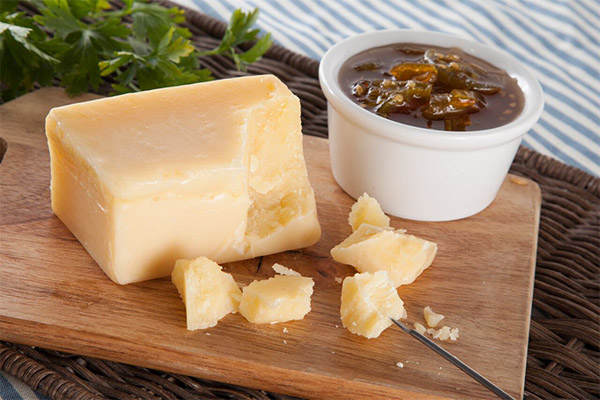
Slowly heat the curd to 51 degrees for 40 minutes, stirring constantly. At this temperature you need to leave the cottage cheese for 20-30 minutes. Then drain the whey with a colander, covered with gauze.
Carefully transfer the cheese to a mold for further pressing under a 5 kg press for half an hour. Next, remove the cheese from the press and turn it over, then press for another 12 hours under a 10 kg nep. At the end of this time, carefully remove the product and place it in a concentrated salt solution for 28-30 hours. During this time it should be turned several times to form an even crust.
Then take the cheese out of the solution, dry it, and put it on a flat surface to get a hard crust. It takes at least five months to mature homemade parmesan. During the first 14 days the delicacy should be turned daily, then - once a week. This is done for even drying. Parmesan should be checked regularly for the presence of mold. Every three months, the cheese should be smeared with olive oil.
What to make with Parmesan cheese: Recipes
Roasted pepper appetizer
You can make an appetizer of roasted peppers using hard cheese. So, you need 4 bell peppers, a few spoons of olive oil, a clove of garlic, a tablespoon of breadcrumbs, a few spoons of Parmesan and spices to taste.
Oil the peppers, place them on a baking sheet and put it in the oven until the skin starts to peel off. After this, cool the peppers and take off their skin. Peeled vegetables should be cut into strips. Then in a pan in oil fry the minced garlic, and then add the peppers. Stew the mass for about 20 minutes, then add salt and spices, sprinkle them with breadcrumbs and mix. It remains only to put the peppers on a plate and sprinkle with grated Parmesan.
Country Pie with Chicken
To prepare a rustic pie with chicken and parmesan you will need 0.5 kg of puff pastry, 0.5 kg of boiled chicken meat, a cup of boiled rice, 150 g of cheese, a cup of cream, 0.5 cup of broth, 2 eggs, as well as herbs and spices.
Chicken meat should be finely chopped, mixed with rice and grated cheese delicacy, add herbs, spices and mix thoroughly. Lay sheets of pastry overlapping on baking paper in such a way that a square twice the size of the future pastry is formed. Place the filling in the center of the square, along the entire perimeter of the dough - grated Parmesan. Then roll up the edges of the dough and press the corners tightly together. The pie should be transferred to a baking tray, pour cream and chicken broth and top with pre-whisked eggs. Bake the pie until golden crust at 180 degrees for half an hour.
Interesting facts about Parmesan
- To obtain Parmesan, the milk of cows that adhered to a special diet is used. They must be fed exclusively hay and grass. Various fodder, silage and other in such a case is forbidden.
- More than 3 million heads of Italian cheese are produced annually, while one head can weigh up to 40 kg.
- In Italy there are people working in the cheese factory who check the quality of Parmesan by tapping the product with a special hammer. It is up to them alone to determine what quality a particular head of cheese gets.
«Important: All information on this site is provided for informational purposes only purposes. Before applying any recommendations, please consult with a specialized specialist before applying any of the recommendations. Neither the editors nor the authors shall be liable for any possible harm caused by materials."

